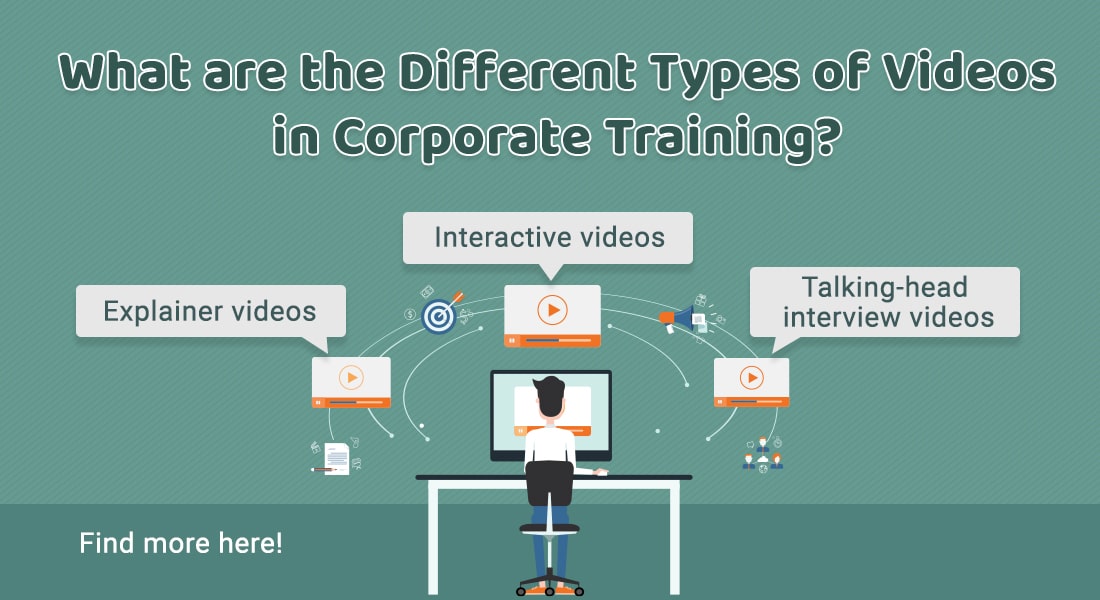5 Types of Videos to Engage your Corporate Learners!

Did you know 78% people watch online videos every week? That 55% view online videos every day? (Biteable). On top of that, while viewers retain 95% of a message when they watch it on video, they only retain a measly 10% when they read it in text. And by 2022, online videos will make up more than 82% of all consumer internet traffic. With the exponential growth in online video consumption, doesn’t it make sense to use this in corporate training?
Videos in Corporate Training: What and When
- Explainer videos – to introduce something, provide context, deliver important messages
- Interactive videos – to enhance engagement, provide opportunity for knowledge application
- Talking-head interview videos – to convey important messages, share personal experiences
- 360-degree videos – to let learners explore and experience without fear of consequences, hands-on training
- Animated videos – to explain or offer perspective, to demonstrate how something works and more
Yes, indeed! In fact, there is a 75% more chance of your employees watching a video than reading something. Video-based learning is creating its own niche in corporate training. Its highly immersive and flexible nature, offering learners the freedom to learn at their own pace and retain the maximum information, are its biggest strengths. As it is also a cost-effective solution, video-based learning is being increasingly adopted by corporate organizations. Microsoft reduced their training costs from $320 per person to just $17 per person when they decided to go with videos instead of in-person classroom training.
All in all, visuals captivate and communicate in a way that is simply not possible with simple images (clickable or not) and text. So, if your organization has been vacillating about using videos in your corporate training this year, this blog is for you!
Here are 5 types of videos you can include in your online training – for a highly engaging learning experience, just what your modern learners want.
Do you know the real eLearning trends for 2021? Sign up for this free webinar and find out!
5 Video Styles for Online Training
1. Explainer Videos
Probably the most-used video type, bite-sized explainer videos have a simple objective – to introduce a product, concept, idea, or even a process. Explainer videos leverage moving graphics (instead of live footage), different fonts or typography, and music for a very engaging experience.
Explainer videos can be used in any format of training – in-person classroom, eLearning, as well as blended learning. These videos are also a good fit in the early stages of training.
| When should you use explainer videos in corporate training? You can leverage the light and fun tone of explainer videos to:
|
2. Interactive Videos
Interactive videos are created by seamlessly blending the video with the course content and interactive elements using eLearning authoring tools, such as Storyline 360 or Adobe Captivate. eLearning interactivities, such as drag-and-drops, multiple choice questions, hotspots, etc. ensure learners actively engage with the content, instead of passively receiving the information. Tools such as Clipchamp offer holistic solutions to develop and edit videos.
While interactive videos do sound fun, it can be challenging to seamlessly combine the video slides with the course content slides. However, that won’t be a problem if you have experienced authoring tools experts onboard. If you don’t, you can outsource the same to an experienced eLearning vendor for faster turnaround.
| When should you use interactive videos in corporate training? You can use interactive videos to:
|
3. Talking-head Interview Videos
One of the most well-known forms of video-based learning and probably the simplest to create, ‘talking-head’ videos simply capture a person talking in front of the camera. This type of video is common in the corporate setting where leaders deliver messages to a large team.
Talking-head videos are short, usually scripted (or at least have an agenda), and are presented in a conversational style, with added background music to keep viewers hooked throughout.
| When should you use talking-head interview videos in corporate training? You can use the conversational talking-head videos to:
|
4. 360-Degree Videos
The newest kid on the block, 360-degree videos are rapidly gaining popularity in corporate L&D because they allow experiential learning. They feature real places with interactions in the form of prompts and other visual effects incorporated within them. They provide learners with a 360-degree view of the learning environment in which they can learn without worrying about failure.
With 360-degree videos in your training programs, learners will stop being passive recipients of information. Instead, they will be protagonists of their own learning journey, engaged in personalized learning paths that will adapt and respond to their decisions and responses.
| When should you use 360-degree videos in corporate training? You can use 360-degree videos to:
|
5. Animated Videos
Certainly a crowd favorite, an animated video is a rich and engaging instrument that helps communicate a story more comprehensively. They are also easy to create and maintain with the help of modern tools such as Vyond, GoAnimate, Powtoon, and more.
| When should you use animated videos in corporate training? You can use animated videos to:
|
To Sum Up!
While videos are being increasingly preferred by modern-day learners, their production costs are also going down, implying enhanced ROI. With the many tools available today, the potential for video-based learning in corporate L&D is only limited by budget and time.
For the record, videos are a very few of the approaches that make it into every eLearning trends list. With reports only showing an upwards trend, we are sure there’s a lot more in store for video-based learning.
Having said that, do you want to know about the other eLearning trends that will rule corporate L&D this year? Download this free eBook for 5 eLearning trends that will certainly improve employee performance, results, and ROI.





